MERCEDES-BENZ SPRINTER 2005 Service Repair Manual
Manufacturer: MERCEDES-BENZ, Model Year: 2005, Model line: SPRINTER, Model: MERCEDES-BENZ SPRINTER 2005Pages: 1232, PDF Size: 39.23 MB
Page 951 of 1232
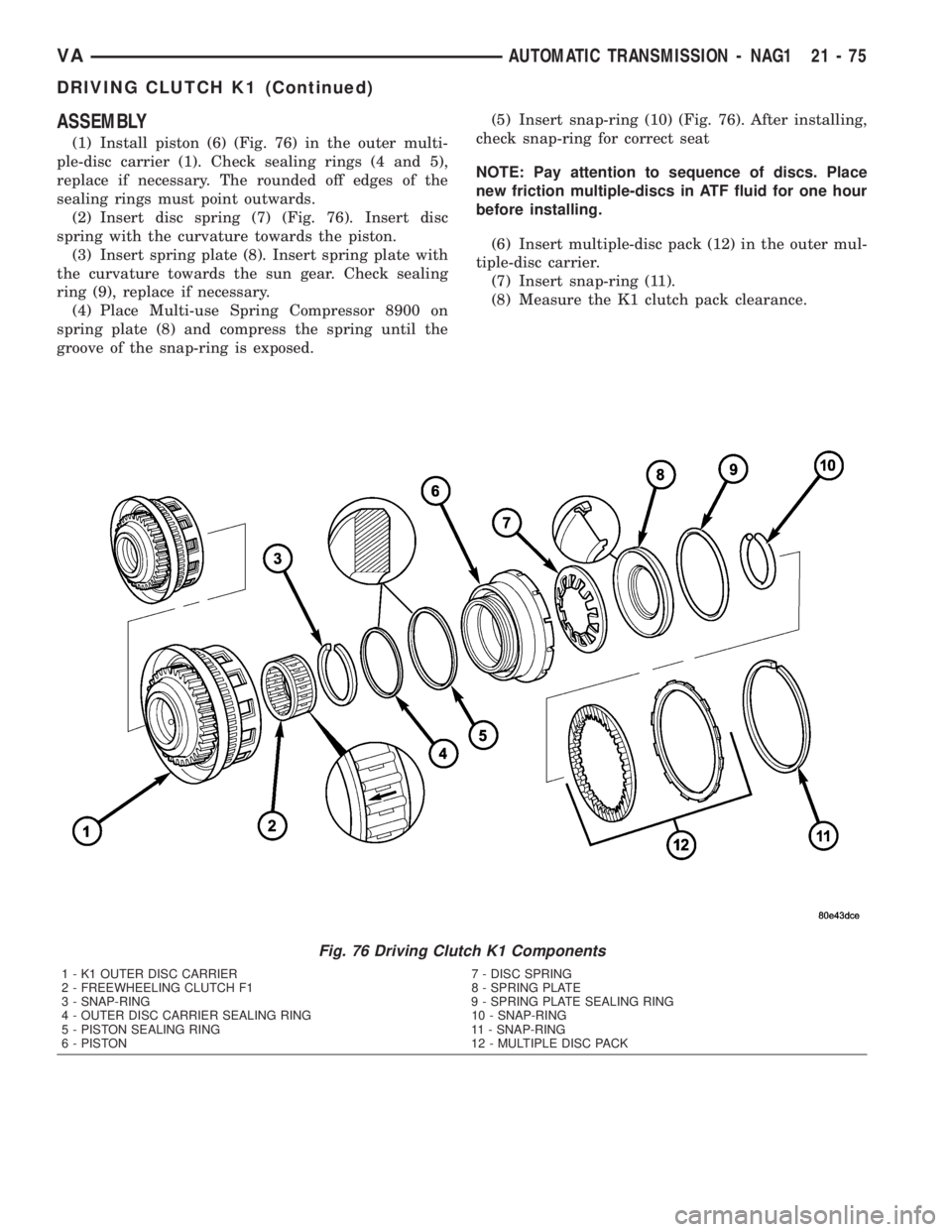
ASSEMBLY
(1) Install piston (6) (Fig. 76) in the outer multi-
ple-disc carrier (1). Check sealing rings (4 and 5),
replace if necessary. The rounded off edges of the
sealing rings must point outwards.
(2) Insert disc spring (7) (Fig. 76). Insert disc
spring with the curvature towards the piston.
(3) Insert spring plate (8). Insert spring plate with
the curvature towards the sun gear. Check sealing
ring (9), replace if necessary.
(4) Place Multi-use Spring Compressor 8900 on
spring plate (8) and compress the spring until the
groove of the snap-ring is exposed.(5) Insert snap-ring (10) (Fig. 76). After installing,
check snap-ring for correct seat
NOTE: Pay attention to sequence of discs. Place
new friction multiple-discs in ATF fluid for one hour
before installing.
(6) Insert multiple-disc pack (12) in the outer mul-
tiple-disc carrier.
(7) Insert snap-ring (11).
(8) Measure the K1 clutch pack clearance.
Fig. 76 Driving Clutch K1 Components
1 - K1 OUTER DISC CARRIER 7 - DISC SPRING
2 - FREEWHEELING CLUTCH F1 8 - SPRING PLATE
3 - SNAP-RING 9 - SPRING PLATE SEALING RING
4 - OUTER DISC CARRIER SEALING RING 10 - SNAP-RING
5 - PISTON SEALING RING 11 - SNAP-RING
6 - PISTON 12 - MULTIPLE DISC PACK
VAAUTOMATIC TRANSMISSION - NAG1 21 - 75
DRIVING CLUTCH K1 (Continued)
Page 952 of 1232
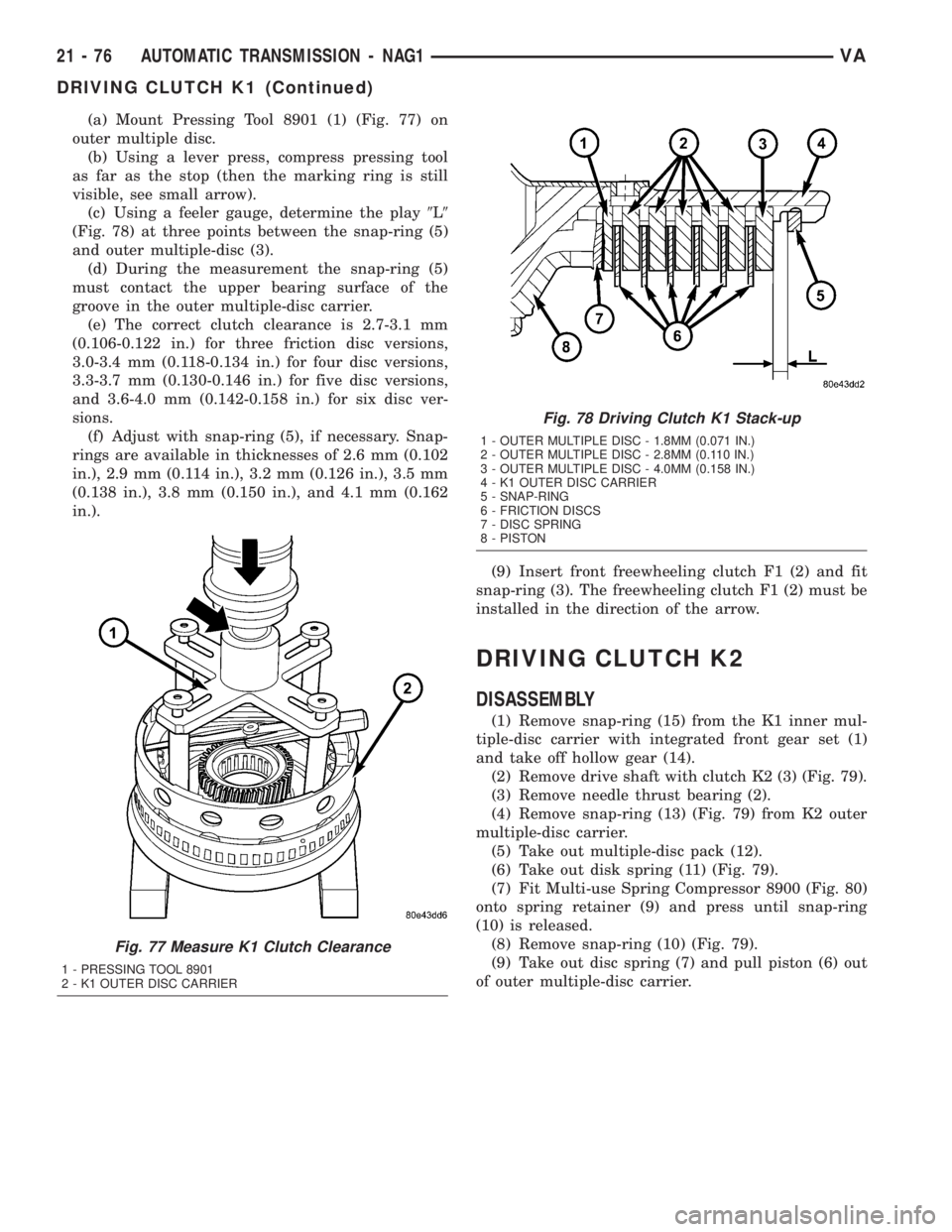
(a) Mount Pressing Tool 8901 (1) (Fig. 77) on
outer multiple disc.
(b) Using a lever press, compress pressing tool
as far as the stop (then the marking ring is still
visible, see small arrow).
(c) Using a feeler gauge, determine the play9L9
(Fig. 78) at three points between the snap-ring (5)
and outer multiple-disc (3).
(d) During the measurement the snap-ring (5)
must contact the upper bearing surface of the
groove in the outer multiple-disc carrier.
(e) The correct clutch clearance is 2.7-3.1 mm
(0.106-0.122 in.) for three friction disc versions,
3.0-3.4 mm (0.118-0.134 in.) for four disc versions,
3.3-3.7 mm (0.130-0.146 in.) for five disc versions,
and 3.6-4.0 mm (0.142-0.158 in.) for six disc ver-
sions.
(f) Adjust with snap-ring (5), if necessary. Snap-
rings are available in thicknesses of 2.6 mm (0.102
in.), 2.9 mm (0.114 in.), 3.2 mm (0.126 in.), 3.5 mm
(0.138 in.), 3.8 mm (0.150 in.), and 4.1 mm (0.162
in.).
(9) Insert front freewheeling clutch F1 (2) and fit
snap-ring (3). The freewheeling clutch F1 (2) must be
installed in the direction of the arrow.
DRIVING CLUTCH K2
DISASSEMBLY
(1) Remove snap-ring (15) from the K1 inner mul-
tiple-disc carrier with integrated front gear set (1)
and take off hollow gear (14).
(2) Remove drive shaft with clutch K2 (3) (Fig. 79).
(3) Remove needle thrust bearing (2).
(4) Remove snap-ring (13) (Fig. 79) from K2 outer
multiple-disc carrier.
(5) Take out multiple-disc pack (12).
(6) Take out disk spring (11) (Fig. 79).
(7) Fit Multi-use Spring Compressor 8900 (Fig. 80)
onto spring retainer (9) and press until snap-ring
(10) is released.
(8) Remove snap-ring (10) (Fig. 79).
(9) Take out disc spring (7) and pull piston (6) out
of outer multiple-disc carrier.
Fig. 77 Measure K1 Clutch Clearance
1 - PRESSING TOOL 8901
2 - K1 OUTER DISC CARRIER
Fig. 78 Driving Clutch K1 Stack-up
1 - OUTER MULTIPLE DISC - 1.8MM (0.071 IN.)
2 - OUTER MULTIPLE DISC - 2.8MM (0.110 IN.)
3 - OUTER MULTIPLE DISC - 4.0MM (0.158 IN.)
4 - K1 OUTER DISC CARRIER
5 - SNAP-RING
6 - FRICTION DISCS
7 - DISC SPRING
8 - PISTON
21 - 76 AUTOMATIC TRANSMISSION - NAG1VA
DRIVING CLUTCH K1 (Continued)
Page 953 of 1232
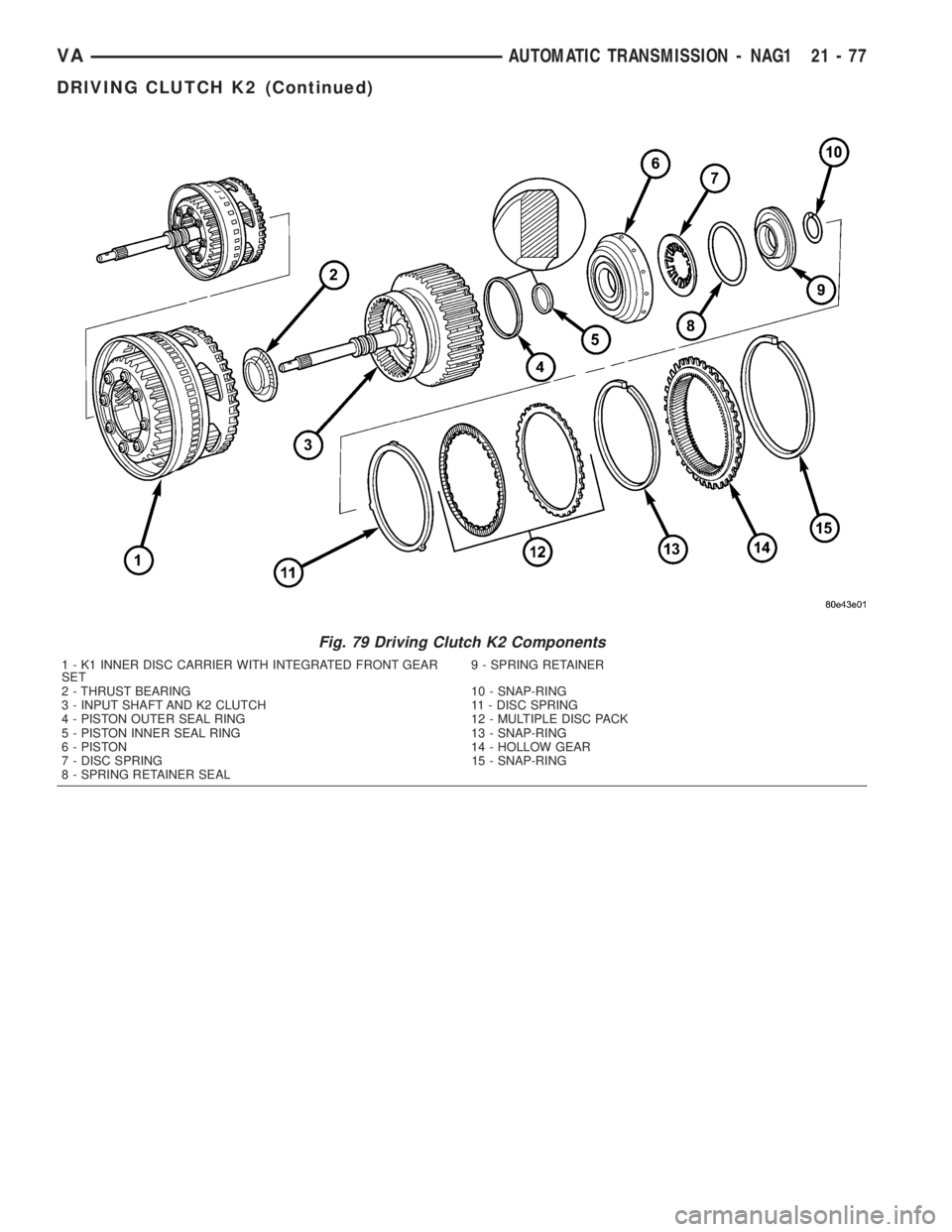
Fig. 79 Driving Clutch K2 Components
1 - K1 INNER DISC CARRIER WITH INTEGRATED FRONT GEAR
SET9 - SPRING RETAINER
2 - THRUST BEARING 10 - SNAP-RING
3 - INPUT SHAFT AND K2 CLUTCH 11 - DISC SPRING
4 - PISTON OUTER SEAL RING 12 - MULTIPLE DISC PACK
5 - PISTON INNER SEAL RING 13 - SNAP-RING
6 - PISTON 14 - HOLLOW GEAR
7 - DISC SPRING 15 - SNAP-RING
8 - SPRING RETAINER SEAL
VAAUTOMATIC TRANSMISSION - NAG1 21 - 77
DRIVING CLUTCH K2 (Continued)
Page 954 of 1232
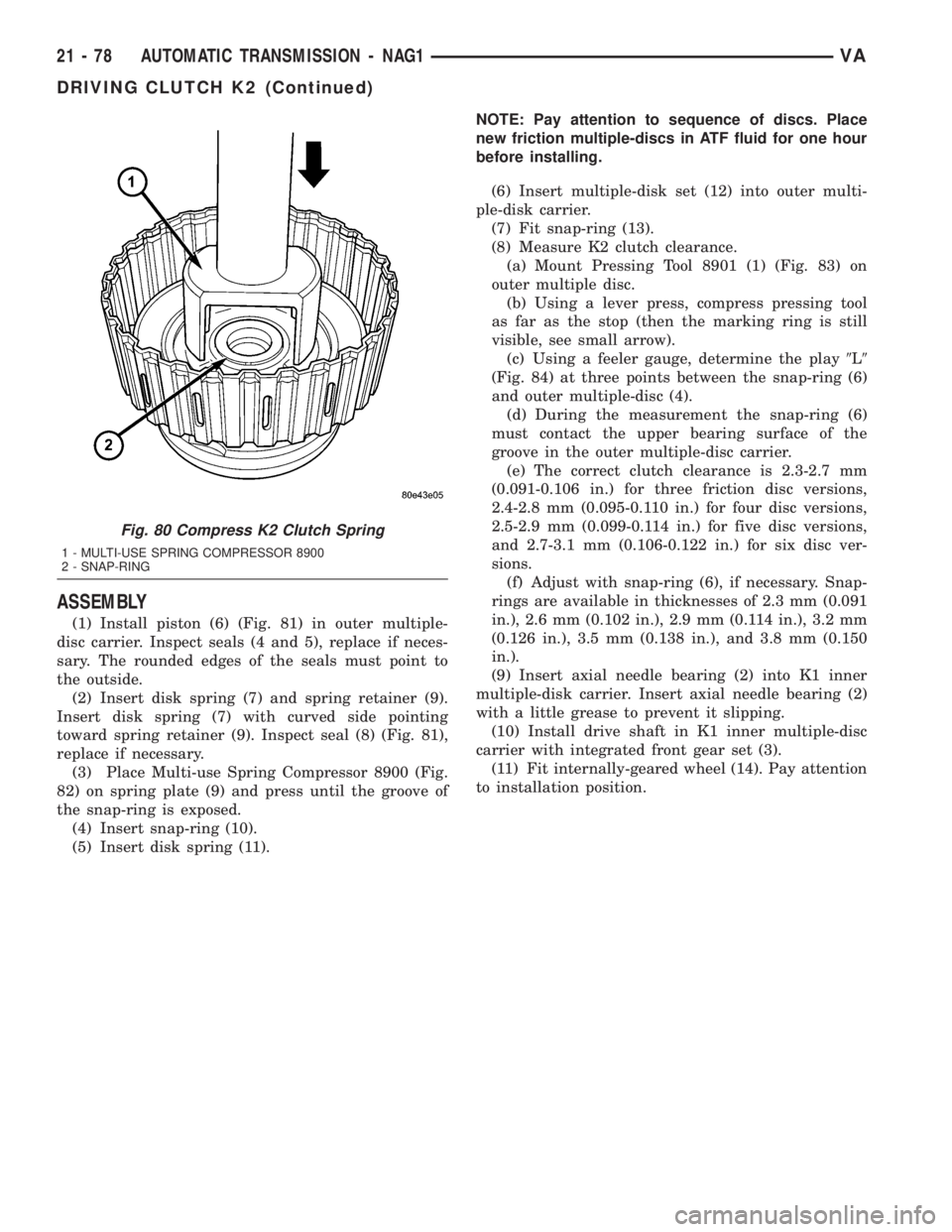
ASSEMBLY
(1) Install piston (6) (Fig. 81) in outer multiple-
disc carrier. Inspect seals (4 and 5), replace if neces-
sary. The rounded edges of the seals must point to
the outside.
(2) Insert disk spring (7) and spring retainer (9).
Insert disk spring (7) with curved side pointing
toward spring retainer (9). Inspect seal (8) (Fig. 81),
replace if necessary.
(3) Place Multi-use Spring Compressor 8900 (Fig.
82) on spring plate (9) and press until the groove of
the snap-ring is exposed.
(4) Insert snap-ring (10).
(5) Insert disk spring (11).NOTE: Pay attention to sequence of discs. Place
new friction multiple-discs in ATF fluid for one hour
before installing.
(6) Insert multiple-disk set (12) into outer multi-
ple-disk carrier.
(7) Fit snap-ring (13).
(8) Measure K2 clutch clearance.
(a) Mount Pressing Tool 8901 (1) (Fig. 83) on
outer multiple disc.
(b) Using a lever press, compress pressing tool
as far as the stop (then the marking ring is still
visible, see small arrow).
(c) Using a feeler gauge, determine the play9L9
(Fig. 84) at three points between the snap-ring (6)
and outer multiple-disc (4).
(d) During the measurement the snap-ring (6)
must contact the upper bearing surface of the
groove in the outer multiple-disc carrier.
(e) The correct clutch clearance is 2.3-2.7 mm
(0.091-0.106 in.) for three friction disc versions,
2.4-2.8 mm (0.095-0.110 in.) for four disc versions,
2.5-2.9 mm (0.099-0.114 in.) for five disc versions,
and 2.7-3.1 mm (0.106-0.122 in.) for six disc ver-
sions.
(f) Adjust with snap-ring (6), if necessary. Snap-
rings are available in thicknesses of 2.3 mm (0.091
in.), 2.6 mm (0.102 in.), 2.9 mm (0.114 in.), 3.2 mm
(0.126 in.), 3.5 mm (0.138 in.), and 3.8 mm (0.150
in.).
(9) Insert axial needle bearing (2) into K1 inner
multiple-disk carrier. Insert axial needle bearing (2)
with a little grease to prevent it slipping.
(10) Install drive shaft in K1 inner multiple-disc
carrier with integrated front gear set (3).
(11) Fit internally-geared wheel (14). Pay attention
to installation position.
Fig. 80 Compress K2 Clutch Spring
1 - MULTI-USE SPRING COMPRESSOR 8900
2 - SNAP-RING
21 - 78 AUTOMATIC TRANSMISSION - NAG1VA
DRIVING CLUTCH K2 (Continued)
Page 955 of 1232
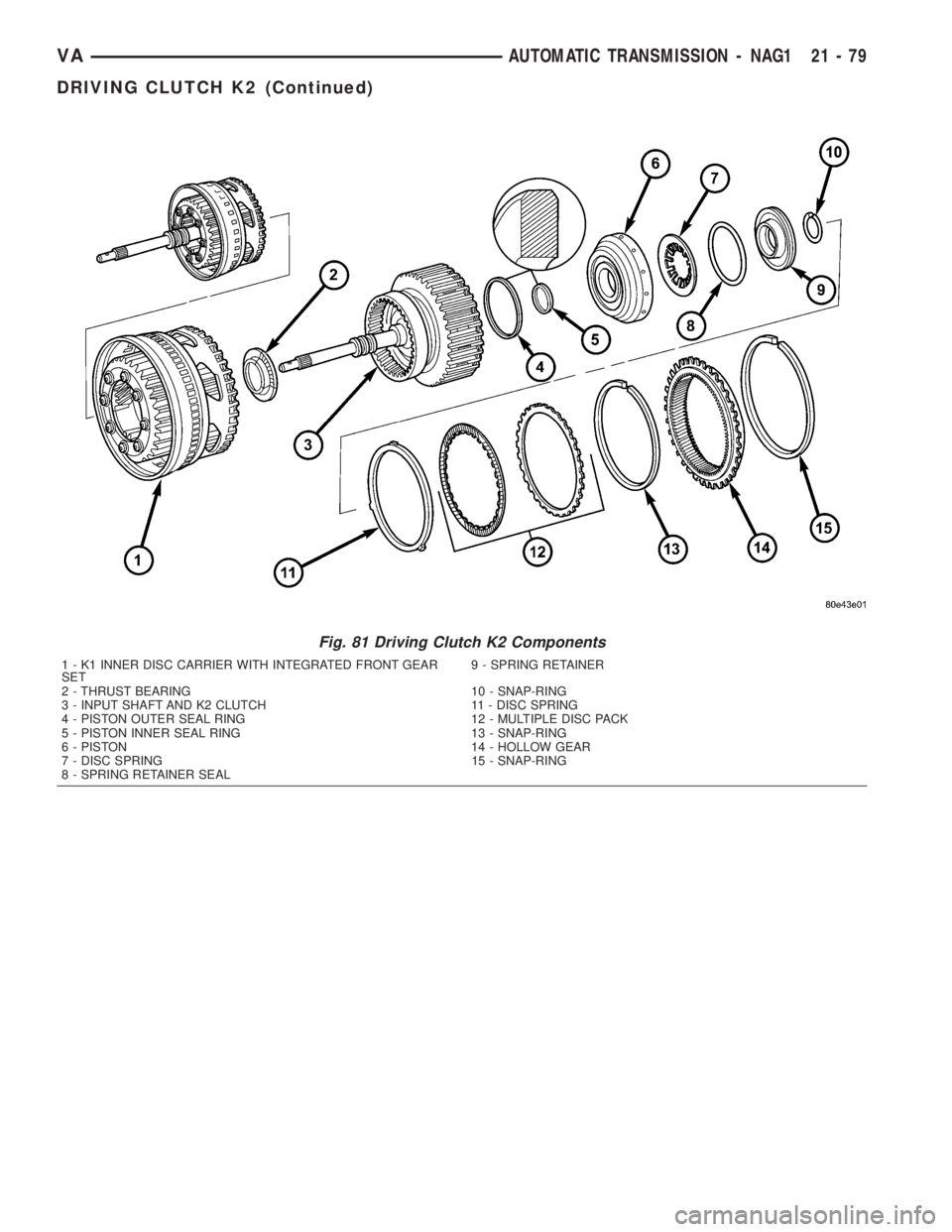
Fig. 81 Driving Clutch K2 Components
1 - K1 INNER DISC CARRIER WITH INTEGRATED FRONT GEAR
SET9 - SPRING RETAINER
2 - THRUST BEARING 10 - SNAP-RING
3 - INPUT SHAFT AND K2 CLUTCH 11 - DISC SPRING
4 - PISTON OUTER SEAL RING 12 - MULTIPLE DISC PACK
5 - PISTON INNER SEAL RING 13 - SNAP-RING
6 - PISTON 14 - HOLLOW GEAR
7 - DISC SPRING 15 - SNAP-RING
8 - SPRING RETAINER SEAL
VAAUTOMATIC TRANSMISSION - NAG1 21 - 79
DRIVING CLUTCH K2 (Continued)
Page 956 of 1232
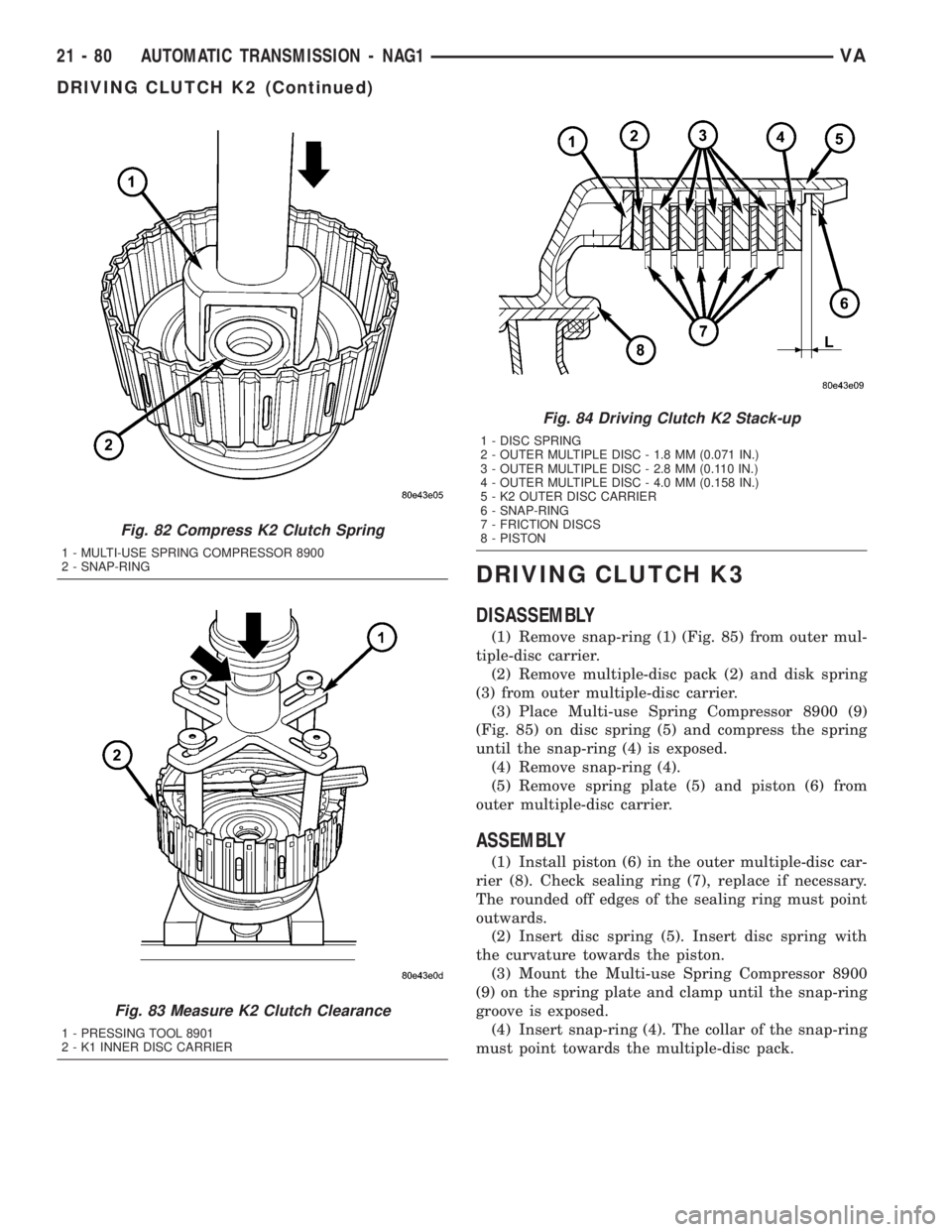
DRIVING CLUTCH K3
DISASSEMBLY
(1) Remove snap-ring (1) (Fig. 85) from outer mul-
tiple-disc carrier.
(2) Remove multiple-disc pack (2) and disk spring
(3) from outer multiple-disc carrier.
(3) Place Multi-use Spring Compressor 8900 (9)
(Fig. 85) on disc spring (5) and compress the spring
until the snap-ring (4) is exposed.
(4) Remove snap-ring (4).
(5) Remove spring plate (5) and piston (6) from
outer multiple-disc carrier.
ASSEMBLY
(1) Install piston (6) in the outer multiple-disc car-
rier (8). Check sealing ring (7), replace if necessary.
The rounded off edges of the sealing ring must point
outwards.
(2) Insert disc spring (5). Insert disc spring with
the curvature towards the piston.
(3) Mount the Multi-use Spring Compressor 8900
(9) on the spring plate and clamp until the snap-ring
groove is exposed.
(4) Insert snap-ring (4). The collar of the snap-ring
must point towards the multiple-disc pack.
Fig. 82 Compress K2 Clutch Spring
1 - MULTI-USE SPRING COMPRESSOR 8900
2 - SNAP-RING
Fig. 83 Measure K2 Clutch Clearance
1 - PRESSING TOOL 8901
2 - K1 INNER DISC CARRIER
Fig. 84 Driving Clutch K2 Stack-up
1 - DISC SPRING
2 - OUTER MULTIPLE DISC - 1.8 MM (0.071 IN.)
3 - OUTER MULTIPLE DISC - 2.8 MM (0.110 IN.)
4 - OUTER MULTIPLE DISC - 4.0 MM (0.158 IN.)
5 - K2 OUTER DISC CARRIER
6 - SNAP-RING
7 - FRICTION DISCS
8 - PISTON
21 - 80 AUTOMATIC TRANSMISSION - NAG1VA
DRIVING CLUTCH K2 (Continued)
Page 957 of 1232
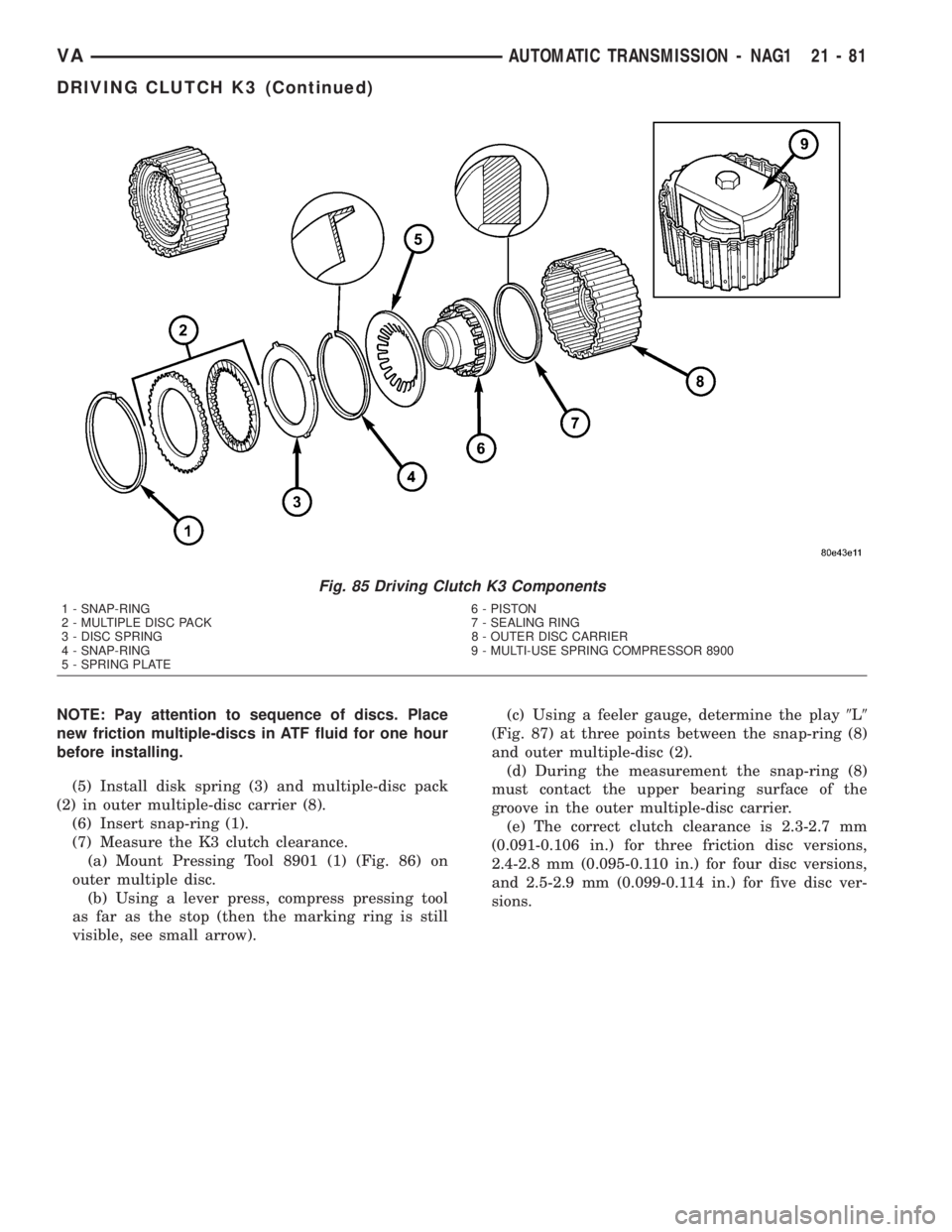
NOTE: Pay attention to sequence of discs. Place
new friction multiple-discs in ATF fluid for one hour
before installing.
(5) Install disk spring (3) and multiple-disc pack
(2) in outer multiple-disc carrier (8).
(6) Insert snap-ring (1).
(7) Measure the K3 clutch clearance.
(a) Mount Pressing Tool 8901 (1) (Fig. 86) on
outer multiple disc.
(b) Using a lever press, compress pressing tool
as far as the stop (then the marking ring is still
visible, see small arrow).(c) Using a feeler gauge, determine the play9L9
(Fig. 87) at three points between the snap-ring (8)
and outer multiple-disc (2).
(d) During the measurement the snap-ring (8)
must contact the upper bearing surface of the
groove in the outer multiple-disc carrier.
(e) The correct clutch clearance is 2.3-2.7 mm
(0.091-0.106 in.) for three friction disc versions,
2.4-2.8 mm (0.095-0.110 in.) for four disc versions,
and 2.5-2.9 mm (0.099-0.114 in.) for five disc ver-
sions.
Fig. 85 Driving Clutch K3 Components
1 - SNAP-RING 6 - PISTON
2 - MULTIPLE DISC PACK 7 - SEALING RING
3 - DISC SPRING 8 - OUTER DISC CARRIER
4 - SNAP-RING 9 - MULTI-USE SPRING COMPRESSOR 8900
5 - SPRING PLATE
VAAUTOMATIC TRANSMISSION - NAG1 21 - 81
DRIVING CLUTCH K3 (Continued)
Page 958 of 1232
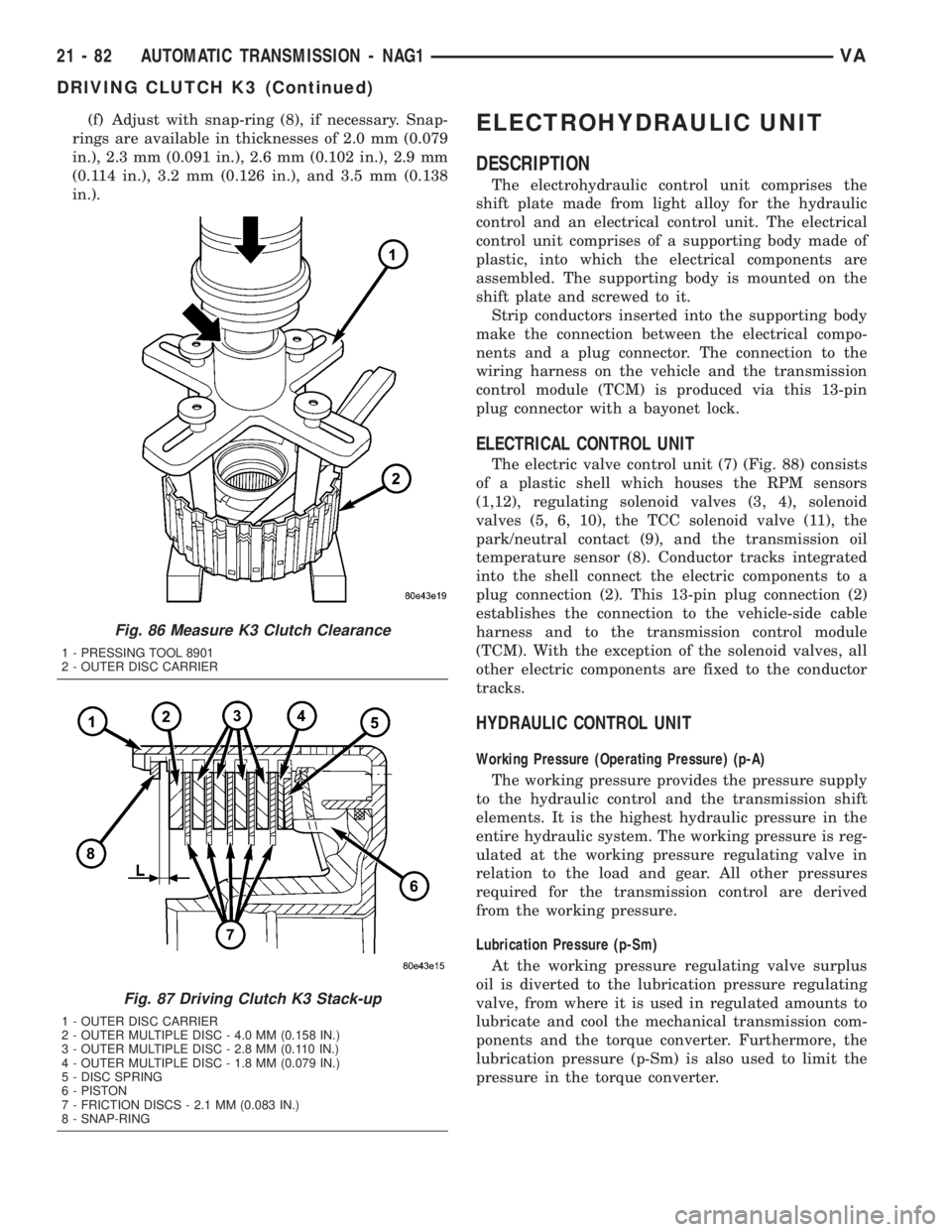
(f) Adjust with snap-ring (8), if necessary. Snap-
rings are available in thicknesses of 2.0 mm (0.079
in.), 2.3 mm (0.091 in.), 2.6 mm (0.102 in.), 2.9 mm
(0.114 in.), 3.2 mm (0.126 in.), and 3.5 mm (0.138
in.).ELECTROHYDRAULIC UNIT
DESCRIPTION
The electrohydraulic control unit comprises the
shift plate made from light alloy for the hydraulic
control and an electrical control unit. The electrical
control unit comprises of a supporting body made of
plastic, into which the electrical components are
assembled. The supporting body is mounted on the
shift plate and screwed to it.
Strip conductors inserted into the supporting body
make the connection between the electrical compo-
nents and a plug connector. The connection to the
wiring harness on the vehicle and the transmission
control module (TCM) is produced via this 13-pin
plug connector with a bayonet lock.
ELECTRICAL CONTROL UNIT
The electric valve control unit (7) (Fig. 88) consists
of a plastic shell which houses the RPM sensors
(1,12), regulating solenoid valves (3, 4), solenoid
valves (5, 6, 10), the TCC solenoid valve (11), the
park/neutral contact (9), and the transmission oil
temperature sensor (8). Conductor tracks integrated
into the shell connect the electric components to a
plug connection (2). This 13-pin plug connection (2)
establishes the connection to the vehicle-side cable
harness and to the transmission control module
(TCM). With the exception of the solenoid valves, all
other electric components are fixed to the conductor
tracks.
HYDRAULIC CONTROL UNIT
Working Pressure (Operating Pressure) (p-A)
The working pressure provides the pressure supply
to the hydraulic control and the transmission shift
elements. It is the highest hydraulic pressure in the
entire hydraulic system. The working pressure is reg-
ulated at the working pressure regulating valve in
relation to the load and gear. All other pressures
required for the transmission control are derived
from the working pressure.
Lubrication Pressure (p-Sm)
At the working pressure regulating valve surplus
oil is diverted to the lubrication pressure regulating
valve, from where it is used in regulated amounts to
lubricate and cool the mechanical transmission com-
ponents and the torque converter. Furthermore, the
lubrication pressure (p-Sm) is also used to limit the
pressure in the torque converter.
Fig. 86 Measure K3 Clutch Clearance
1 - PRESSING TOOL 8901
2 - OUTER DISC CARRIER
Fig. 87 Driving Clutch K3 Stack-up
1 - OUTER DISC CARRIER
2 - OUTER MULTIPLE DISC - 4.0 MM (0.158 IN.)
3 - OUTER MULTIPLE DISC - 2.8 MM (0.110 IN.)
4 - OUTER MULTIPLE DISC - 1.8 MM (0.079 IN.)
5 - DISC SPRING
6 - PISTON
7 - FRICTION DISCS - 2.1 MM (0.083 IN.)
8 - SNAP-RING
21 - 82 AUTOMATIC TRANSMISSION - NAG1VA
DRIVING CLUTCH K3 (Continued)
Page 959 of 1232
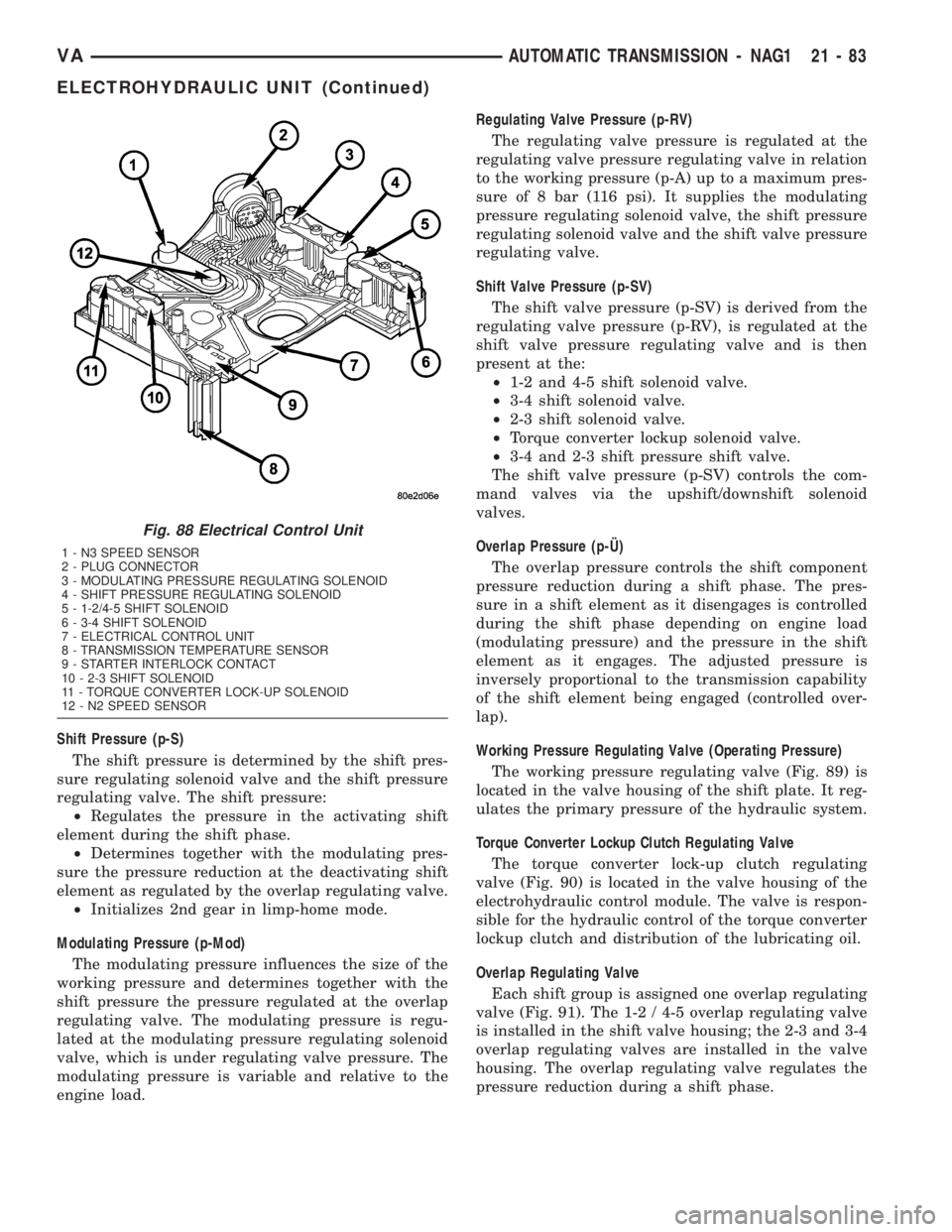
Shift Pressure (p-S)
The shift pressure is determined by the shift pres-
sure regulating solenoid valve and the shift pressure
regulating valve. The shift pressure:
²Regulates the pressure in the activating shift
element during the shift phase.
²Determines together with the modulating pres-
sure the pressure reduction at the deactivating shift
element as regulated by the overlap regulating valve.
²Initializes 2nd gear in limp-home mode.
Modulating Pressure (p-Mod)
The modulating pressure influences the size of the
working pressure and determines together with the
shift pressure the pressure regulated at the overlap
regulating valve. The modulating pressure is regu-
lated at the modulating pressure regulating solenoid
valve, which is under regulating valve pressure. The
modulating pressure is variable and relative to the
engine load.Regulating Valve Pressure (p-RV)
The regulating valve pressure is regulated at the
regulating valve pressure regulating valve in relation
to the working pressure (p-A) up to a maximum pres-
sure of 8 bar (116 psi). It supplies the modulating
pressure regulating solenoid valve, the shift pressure
regulating solenoid valve and the shift valve pressure
regulating valve.
Shift Valve Pressure (p-SV)
The shift valve pressure (p-SV) is derived from the
regulating valve pressure (p-RV), is regulated at the
shift valve pressure regulating valve and is then
present at the:
²1-2 and 4-5 shift solenoid valve.
²3-4 shift solenoid valve.
²2-3 shift solenoid valve.
²Torque converter lockup solenoid valve.
²3-4 and 2-3 shift pressure shift valve.
The shift valve pressure (p-SV) controls the com-
mand valves via the upshift/downshift solenoid
valves.
Overlap Pressure (p-š)
The overlap pressure controls the shift component
pressure reduction during a shift phase. The pres-
sure in a shift element as it disengages is controlled
during the shift phase depending on engine load
(modulating pressure) and the pressure in the shift
element as it engages. The adjusted pressure is
inversely proportional to the transmission capability
of the shift element being engaged (controlled over-
lap).
Working Pressure Regulating Valve (Operating Pressure)
The working pressure regulating valve (Fig. 89) is
located in the valve housing of the shift plate. It reg-
ulates the primary pressure of the hydraulic system.
Torque Converter Lockup Clutch Regulating Valve
The torque converter lock-up clutch regulating
valve (Fig. 90) is located in the valve housing of the
electrohydraulic control module. The valve is respon-
sible for the hydraulic control of the torque converter
lockup clutch and distribution of the lubricating oil.
Overlap Regulating Valve
Each shift group is assigned one overlap regulating
valve (Fig. 91). The 1-2 / 4-5 overlap regulating valve
is installed in the shift valve housing; the 2-3 and 3-4
overlap regulating valves are installed in the valve
housing. The overlap regulating valve regulates the
pressure reduction during a shift phase.
Fig. 88 Electrical Control Unit
1 - N3 SPEED SENSOR
2 - PLUG CONNECTOR
3 - MODULATING PRESSURE REGULATING SOLENOID
4 - SHIFT PRESSURE REGULATING SOLENOID
5 - 1-2/4-5 SHIFT SOLENOID
6 - 3-4 SHIFT SOLENOID
7 - ELECTRICAL CONTROL UNIT
8 - TRANSMISSION TEMPERATURE SENSOR
9 - STARTER INTERLOCK CONTACT
10 - 2-3 SHIFT SOLENOID
11 - TORQUE CONVERTER LOCK-UP SOLENOID
12 - N2 SPEED SENSOR
VAAUTOMATIC TRANSMISSION - NAG1 21 - 83
ELECTROHYDRAULIC UNIT (Continued)
Page 960 of 1232
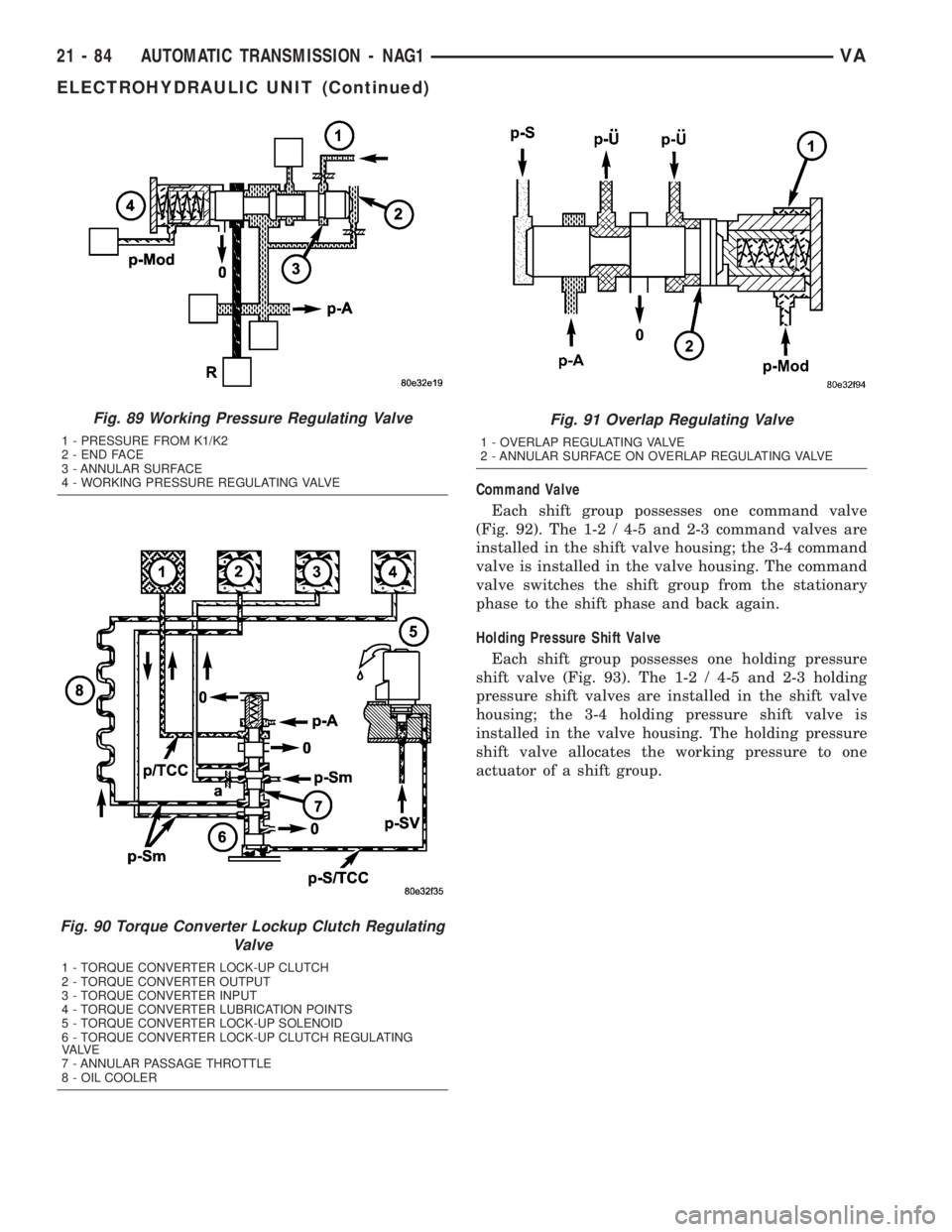
Command Valve
Each shift group possesses one command valve
(Fig. 92). The 1-2 / 4-5 and 2-3 command valves are
installed in the shift valve housing; the 3-4 command
valve is installed in the valve housing. The command
valve switches the shift group from the stationary
phase to the shift phase and back again.
Holding Pressure Shift Valve
Each shift group possesses one holding pressure
shift valve (Fig. 93). The 1-2 / 4-5 and 2-3 holding
pressure shift valves are installed in the shift valve
housing; the 3-4 holding pressure shift valve is
installed in the valve housing. The holding pressure
shift valve allocates the working pressure to one
actuator of a shift group.
Fig. 89 Working Pressure Regulating Valve
1 - PRESSURE FROM K1/K2
2 - END FACE
3 - ANNULAR SURFACE
4 - WORKING PRESSURE REGULATING VALVE
Fig. 90 Torque Converter Lockup Clutch Regulating
Valve
1 - TORQUE CONVERTER LOCK-UP CLUTCH
2 - TORQUE CONVERTER OUTPUT
3 - TORQUE CONVERTER INPUT
4 - TORQUE CONVERTER LUBRICATION POINTS
5 - TORQUE CONVERTER LOCK-UP SOLENOID
6 - TORQUE CONVERTER LOCK-UP CLUTCH REGULATING
VA LV E
7 - ANNULAR PASSAGE THROTTLE
8 - OIL COOLER
Fig. 91 Overlap Regulating Valve
1 - OVERLAP REGULATING VALVE
2 - ANNULAR SURFACE ON OVERLAP REGULATING VALVE
21 - 84 AUTOMATIC TRANSMISSION - NAG1VA
ELECTROHYDRAULIC UNIT (Continued)